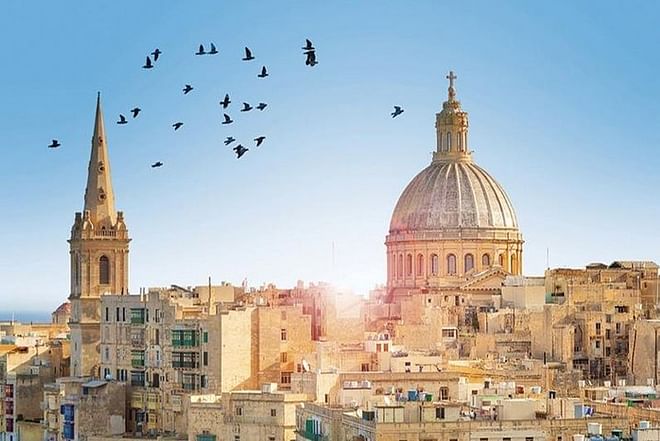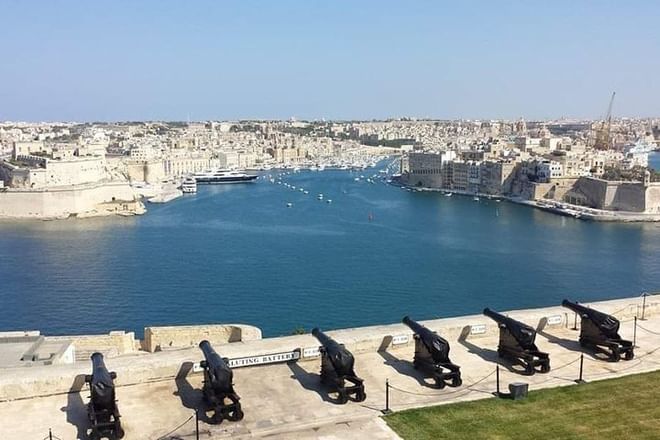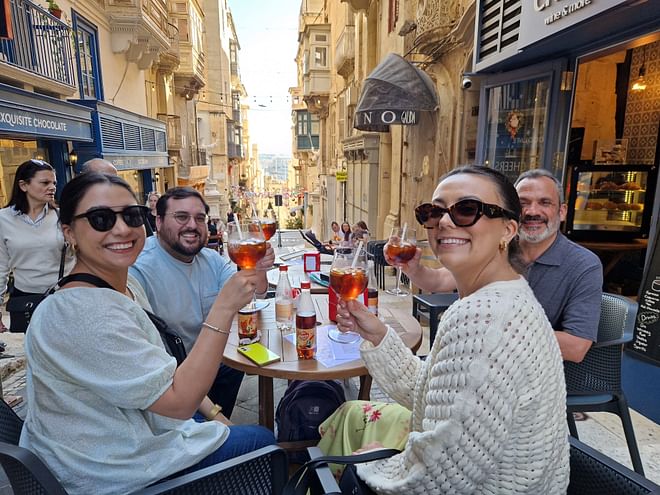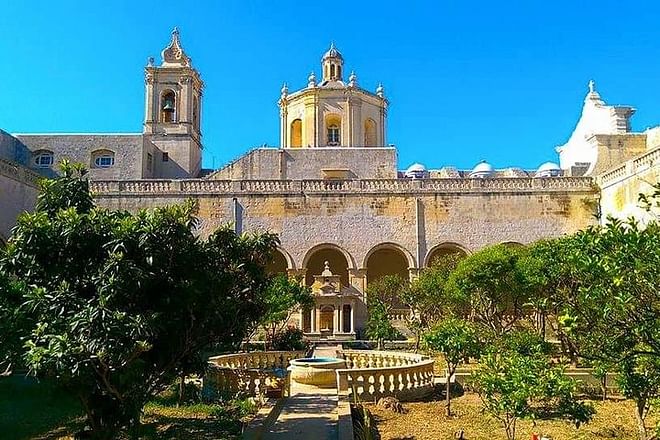The Republic of Malta is an archipelago comprised of five islands: Malta, Gozo, Comino, Cominotto and Filfla. It lies south of Sicily and north of Tunisia. It has been inhabited for over 7,000 years thanks to its strategic location in the middle of the Mediterranean Sea, and numerous civilizations have inhabited the islands: the Phoenicians, Greeks, Romans, Arabs, Spanish, French and British.
Malta has a surface area of 316 km2 and 253 km of coastline, making it one of the smallest countries in the world. It has around half a million inhabitants and its capital, Valletta, in the island of Malta, has just over 5,000 residents.
Malta is a popular destination for tourists who want a peaceful holiday and the chance to visit pristine islands: this archipelago certainly offers both. The islands of Cominotto and Filfla are uninhabited, and only a few people live in Comino. The islands attract both young people who come here to study English (and enjoy the nightlife), and tourists seeking sunshine, beaches, and coves with transparent, turquoise waters.
Any time of year is a good time to visit the islands because they proudly claim to have 300 days of sunshine a year and a mild Mediterranean climate. Having said that, winter is cooler and wetter, while summer is much hotter with high temperatures.
Fishing villages, beaches and coves set in beautiful rocky settings, scuba diving spots, and cities with the fascinating remains of the archipelago’s historical past are just some of the reasons to travel to Malta with friends.
Below is a selection of activities to do if you travel with friends to Malta.
Discover the history of Malta
Valletta
Valletta is the capital of the Republic of Malta and is in the eastern centre of Malta. It’s steeped in history and contains 320 monuments in just 55 hectares.
It’s the perfect place to discover the history of the Order of Malta, also known as the Knights of Malta or the Sovereign Military Hospitaller Order of Saint John of Jerusalem. In 1530, King Charles I of Spain ceded the islands of Malta, Gozo, and Comino to this religious order. It had been officially recognised in 1113 but its beginnings can be traced all the way back to 1048 in Jerusalem.
The archipelago frequently needed protection from invaders; in 1565, with support from the Spanish army, the Knights fought off thousands of Ottoman soldiers to defend the islands. As a result, in 1566, work began on a walled city that faced the sea on the Mount Sceberras peninsula. Jean Parisot de la Valette, Grand Master of the Order of St John, started the project and gave it his name: Valletta.

Jean Parisot de la Valette died before the city was completed. It remained virtually intact until the arrival of Napoleon and today, despite having been heavily damaged during the Second World War, tourists are fascinated to see St Elmo’s Fort, St John’s Co-Cathedral, the National Archaeology Museum, and the majestic Grand Master’s Palace, among other historical buildings.
The city is characterised by cobbled streets, limestone façades, forged iron balconies and Baroque buildings, and the old town was made a UNESCO World Heritage Site in 1980.
Senglea, Vittoriosa and Cospicua
The Cottonera is an area next to Valletta and it’s where you’ll find the historical cities of Cospicua, Senglea and Vittoriosa, known as the “Three Cities of Malta”. A wonderful way to admire their historic beauty is by taking a ride in a “Maltese gondola”.
The Knights of Malta, today known as the Order of Malta, built these fortified towns over the Grand Harbour natural port as a containing wall to protect the island from Ottoman attacks. The harbour where the cities stand had been used since Roman times, functioning as a refuge and defensive zone for the various peoples that inhabited Malta over thousands of years.

Senglea is the smallest, and the starting point if you would like to explore the three cities on foot. Highlights include Fort St Michael, built by the Knights of Malta. Vittoriosa was the former capital of the Knights of Malta and is home to Fort St Angel, which dominates the city and port. Finally, Cospicua is famous for the church of the Immaculate Conception, one of the most important churches in Malta.
The Hypogeum
The Hypogeum, in Paola municipality in south-east Malta, is a 5,000-year-old ancient necropolis that is the only one of its kind in the world. It was made a UNESCO World Heritage Site in 1980.
The Hypogeum of Ħal Saflieni was discovered at the beginning of the 20th century by workers who were cutting the ground to build cisterns. It’s thought that this underground structure was originally a sanctuary and turned into a necropolis over the years.
It has a complex system of galleries, tunnels, and small inter-connected rooms, with three levels beneath the ground. Fascinating ochre paintings can still be glimpsed on some of the ceilings.
Since its discovery, human skeletons, pottery, and amulets have also been unearthed, plus other objects of historical interest that are on display in the National Archaeology Museum in Valletta.
Beaches, coves, and diving
Malta’s glorious sunshine and warm temperatures mean tourists to Malta flock to the islands’ coves and beaches for swimming and scuba diving, among other activities. So, heading to the coast and beaches is a great idea if you’re travelling to Malta with friends.
Malta, Gozo, and Comino have sheer cliffs and idyllic coastal spots that visitors will love. The islands’ transparent, turquoise waters have formed rocky coves, golden sand beaches, and natural pools and lagoons that are rich in marine life.
In the island of Malta, St Peter’s Pool is one of the most popular places for a swim. This natural pool of crystal-clear waters is located at the tip of Delimara Point (to the south-east of the island of Malta), sheltered by rocks resembling a giant horseshoe. It’s also a perfect spot for scuba diving. Golden Bay, in the north-east of Malta, is one of the most popular beaches with tourists thanks to its generous size and golden sand. Other recommended beaches and coves include: Ghadira Bay (near Mellieha) and Paradise Bay (in the north).

Comino Island is home to the Blue Lagoon, the most idyllic and popular cove in the Maltese archipelago. Its name derives from the deep blue hue of its crystalline waters. Many tourists want to swim in its iconic glimmering waters, while diving enthusiasts are attracted by chance to see the marine fauna that inhabits its seabed.
Ramla Bay is in the north of Gozo, near Xaghra. The beach is famous for its golden sand (its name is derived from the Maltese word “ir-ramla”, meaning “red sand”), which is lapped by gorgeous turquoise waters. The beautiful beach is also surrounded by a stunning sequence of fields and orchards that stretch for as far as the eye can see. The picturesque scenery makes it a favourite destination for scuba diving and snorkelling enthusiasts.

Visit the islands of Comino and Gozo
Malta, Gozo, and Comino are the three most famous and popular islands to visit in the Maltese archipelago. Both Comino and Gozo are well worth visiting for a day or two. You can travel to the islands by ferry, and boats depart from Ċirkewwa port in north-west Malta.
Gozo Island can be reached in just over 20 minutes by ferry from Malta. It’s a peaceful place with a stunning coastline that has picturesque spots for scuba diving among caves and sunken ships, villages with stone houses and churches, and historical remains that date from thousands of years ago. They were built by cultures and civilizations that lived here or passed through the island, including the Byzantines, Romans, Ottomans, Aragonese, Spanish, French, etc.
Some of the tourist attractions to visit are Ġgantija, a temple complex that was built 5,000 years ago; Victoria, the capital, and its 13th century citadel; and the 2,000-year-old salt mines at Marsalforn fishing village.
Comino is halfway between Malta and Gozo; it’s the smallest island in the Republic of Malta and is practically uninhabited. It’s famous for its turquoise waters, caves, coves, and sheer limestone cliffs, and is particularly popular with diving enthusiasts. It is also a popular birdwatching destination.

Enjoy the nightlife
If you’re travelling with friends to Malta and would like a night or two out partying, the island has plenty of nightlife to enjoy. This is a major attraction for many international students who come to Malta for weeks or months at a time to study English, with this being one of the archipelago’s two official languages.
All the nightclubs are on the island of Malta; most are in Paceville neighbourhood, in the north of St Julian’s. Many late-night bars, Irish pubs and nightclubs can be found along Dragonara Road, Wilga Street, St. Georges Road, and St. Rita Steps. The Portomaso Marina is also home to several nightclubs, although these tend to be for more exclusive clientèle.

Some of the most famous nightclubs are: Havana (St. George’s Road, in Paceville), Sky Club Malta (a five-minute walk from Havana) and Gianpula Club (a half-hour drive from Paceville).
Like other Mediterranean coastal cities and islands, Malta has a “fleet” of party boats that give you the chance to party the night away while sailing the sea at the same time. One of the most famous party boats is Lazy Pirate Boat Party Malta.
Tips and recommendations
Many low-cost airlines such as Vueling, Easyjet and Ryanair travel regularly to Malta, and it’s also served by companies including British Airways, Iberia, and Lufthansa too.
If you travel to Malta in summer, be prepared for high temperatures and humid heat. Summer is also high season, so your accommodation may be pricier and harder to find. However, it’s also the best time of year for nightlife.
If you visit Malta in winter, temperatures are normally mild, with averages of 15⁰C, but it can be windy and rain is more common. It’s a great time to find reasonably priced accommodation and to visit the islands when they are less crowded.
If you’re travelling from the EU, you just need to take your ID card, and the local currency is euros. Speaking some English is enough to communicate with local people and at hotels, restaurants, and nightclubs.
Where to stay in Malta
If, like most people, you plan to use Malta as a base, the Barceló hotel chain has a five-star hotel in the capital, Valletta: hotel Barceló Fortina Malta.
Located right on Sliema’s beachfront promenade and with views across the UNESCO-recognised city of Valetta, this wonderful hotel has 183 rooms with their own private terrace, most of which have views of the capital. The hotel also boasts an adults-only spa service and a menu comprising a wide range of delicious local and international cuisine.
It is a luxurious and comfortable option for those looking to explore Malta and visit the island of Gozo in one or two days.

















































































